1. Introduction
Your bed is a major contributor to your comfort at home. After all, you spend about a third of your day in it, so you might as well ensure that those 8 hours are comfortable. This post provides a guide on how to choose the right bed for yourself. It explores the following 6 aspects of bed design you should consider when selecting or designing a bed:
- Size of the bed
- Height of the bed
- Build material of the bed
- Headboard options
- Box-bed options (under-bed storage)
- Make vs buy (custom-made vs ready-made)
Quick note: Did you have a mattress in mind instead of a bed?
We often use the words ‘bed’ and ‘mattress’ interchangeably. So in case you had a mattress in mind, I have written a separate post on how to choose a mattress. That post delves into the types of mattress and key selection criteria to help you identify one that’s optimally suited to your needs.
2. Selecting the right size of bed
2.1 Standard bed sizes
Bed sizes are mapped to the standard sizes of mattresses available in the market. However, if you custom-make your bed to a different dimension, you will have to get a custom-made mattress as well, which in turn will limit your options and increase your cost. As far as possible, try to stick to the standard sizes.
There are mainly 3 sizes of beds, based on their width of the mattress:
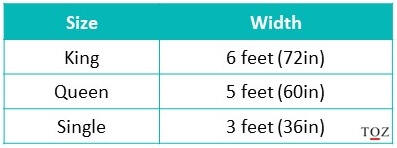
Each of the 3 sizes above will have 4 options of length viz. 72, 75, 78 and 84 inches. The difference may seem small, but a wrong choice of length could mean that you have your feet dangling out of the bed during a cold winter night.
Choose the length based on the height of the tallest person who will sleep on the bed.
Queen and king size beds can accommodate 2 adults and are the most commonly purchased sizes. Single beds are best suited for guest rooms or kids’ bedrooms.
2.2 King size or Queen size bed: 4 factors to help you decide
- Your sleeping preference
Think about how you and your partner prefer to sleep. Some like to curl into a bundle when sleeping, while some prefer to spread themselves out. If you are the latter, then a king size bed would make more sense.
- Sharing the bed with your toddler
This is important if you have a toddler at home or are planning to have a child in the near future. While some children are fine to move from the crib to their own bed, a lot of them prefer to sleep in the same bed as their parents. And given the acrobatics children are known to perform during their sleep, it’s not uncommon for parents to be curled up on the 2 sides of the bed, while their child between them rotates through 360 degrees all through the night. So a king size bed would be better in this case.
- Space planning of the room
A larger bed could limit your ability to keep other furniture in the bedroom or make it too crammed-up to navigate the room with ease. Hence, a space planning exercise of your bedroom can prove to be valuable in arriving at the right size of bed. Space planning is about understanding your space constrains, and using a systematic approach to identify potential layout options of your bedroom by taking into account various factors, such as, your storage needs, direction of natural light, other furniture in the room (say, a study table or sideboard), Vastu (in case you follow it), religious considerations and ease of navigating the room.
- Other activities
Many use the bed for not just sleeping, but also for playing with kids, working, reading or simply lazing around. A larger bed may prove useful in such cases.
3. Height of the bed
The height of the bed is the distance from the floor to the top of your mattress. Bed height not only affects the ease with which you can get on or off the bed, but also the overall look of the bedroom.
- Low height beds give a spacious feel to the room. However, your knees are above your hips when you are sitting, making it difficult to get out of bed. This is particularly important if you have older people at home. Low height beds also have little potential for under-bed storage.
- Higher beds, on the other hand, allow for greater under-bed storage. They are easier on the knees when you are trying to get off them, but it becomes difficult for older people to climb onto them.
3.1 How to find the ideal bed height
The ideal bed height depends on the height of the person using it. The ideal height would be when you sitting on the edge of your bed with your feet flat on the floor and your knees at a 90- degree angle.
Since mattresses also come in varying thicknesses, you must consider both the bed and mattress in tandem and finalise both together.
Mattress selection itself is a vast topic, that requires a dedicated focus. I have written a separate post on selecting the right mattress that delves into the types of mattress and selection key criteria, to help you identify one that’s optimally suited to your needs.
4. Different build materials for beds
There are primarily 4 types of beds based on the material used to make them:
4.1 Solid wood
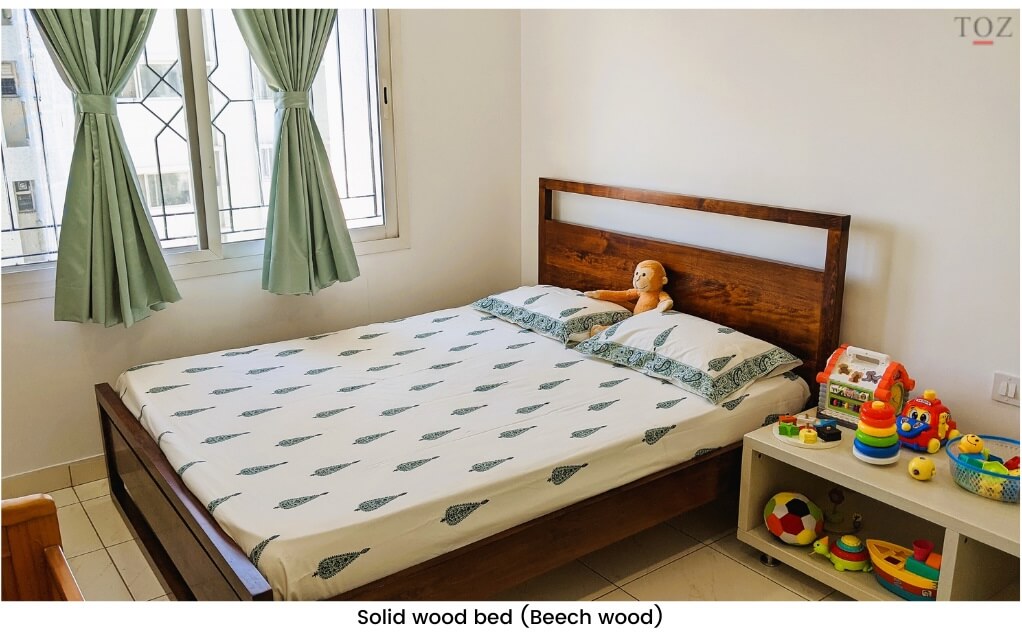
Solid wood beds are heavy, sturdy and known to last for generations. They can be made modular (for easy dismantling) and can be carved to create a wide variety of designs. But all those benefits come at a cost, and a significant one for that matter, making them among the most expensive beds out there. If you’re planning to use the bed for the next 25 years or more, solid wood beds are the cheapest option in the longer run, as the other beds generally need to be replaced much earlier, thereby inflating your costs. The price of a solid wood bed is significantly influenced by the kind of wood used. For instance, the most premium ones are made of teak. Mango wood and Beech wood are popular options that are fairly sturdy, have a unique earthy look and not astronomically expensive. Pine wood is not ideal for making beds though I have seen them in a few stores. These beds are quite cheap, but they lack strength and start creaking in a few years.
4.2 Plywood
These beds are cheaper than wooden ones, sturdy and can be made modular. Being lighter than wood, it is easier to shift these beds within a room and also easier to dismantle while moving to a new house. However, they don’t have the versatility of wood in terms of creating intricate designs on its surface, so designs are relatively simple. Plywood beds typically would have a layer of laminate or veneer on them.
4.3 Fibreboard (HDF / MDF / PB)
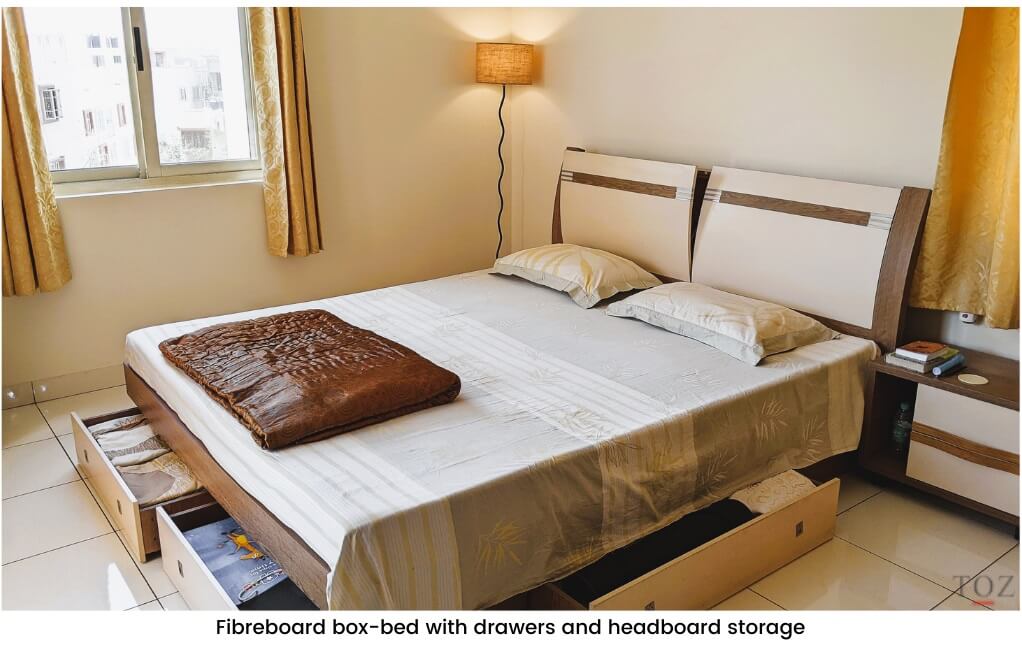
Fibreboard is made by mixing wood fibres with wax and resins and then compressing them under high heat to create sheets having a very smooth finish. The biggest advantage of fibreboard is that since they are machine-made, the machines can be programmed to generate boards of any shape and create a wide variety of intricate designs on its surface. Fibreboards are finished with a wide variety of coatings using machines making the finished product visually appealing.
Fibreboards come in 3 types based on the quality of bonding and pressure used to manufacture them. High density fibreboard (HDF) is the best among them, followed by medium density fibreboard (MDF) and Particle board (PB) in decreasing order of cost, strength and durability.
4.3.1 HDF beds (High density fibreboard)
HDF beds are the best among fibreboard beds. While it loses out to plywood on strength and durability, it makes up in terms of the design possibilities. It is always a tough call between HDF and plywood beds as they are priced very close to each other. If you are looking for a simple design, opt for plywood. But if you want something more artistic with a lot of curves and intricate detailing, HDF would make more sense.
4.3.2 MDF beds (Medium density fibreboard)
MDF beds are the most common type of beds that the markets are flooded with. They look same as HDF beds, but are significantly cheaper and consequently purchased by many. The biggest issue with these beds is their poor durability; they typically start creaking in a few years.
Avoid MDF beds if you plan to shift homes often – since each time you dismantle it, the fibreboard disintegrates a bit near the screws leading to fibre particles falling out and making the bed further lose its sturdiness.
You can consider MDF beds in case you don’t intend to shift the bed much (even in your own house), or need a bed only for a few years.
4.3.3 PB beds (Particle board)
Particle board beds are neither sturdy nor durable and barely last beyond a year or two. If you find a bizarre deal like one where the bed comes free with a mattress purchase, chances are it is a PB bed. Particleboard is more suited for small furniture items that carry little load. Frankly, I am not sure why manufacturers even make beds with it.
4.4 Metal
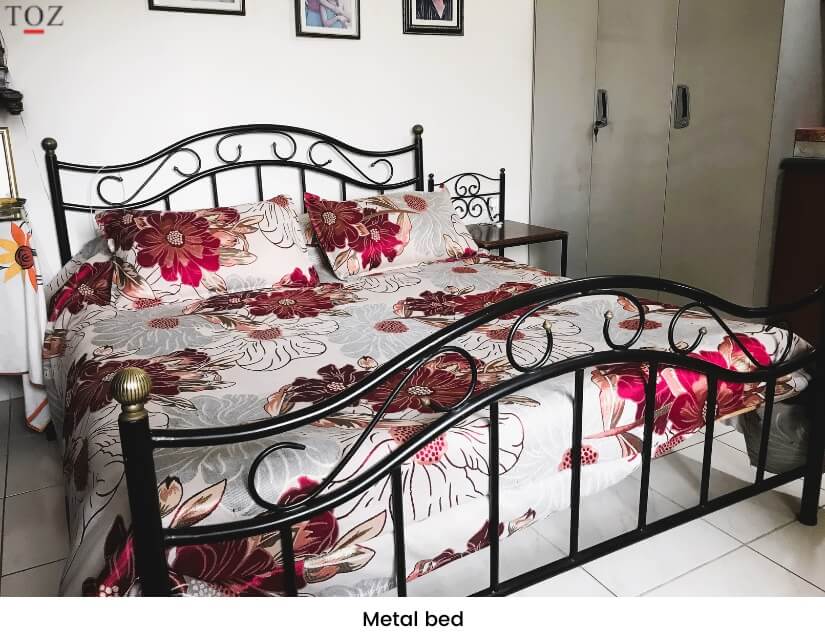
Wrought iron beds are the most common type of metal beds. Metal gives these beds a unique look as opposed to the other wood-based beds. Though metal beds are sturdy, a common complaint is that these beds start making creaking noises after 3-4 years. These beds are generally inexpensive and are suited for short-term use.
Personal experience:
I have used wood, plywood, MDF and metal beds and here’s what I think:
- The wooden and the plywood beds were sturdy and lasted me a decade before I decided to sell them. It was easy to sell and I got a very good price for both.
- I found the plywood bed the best value for money. It cost lesser than the wooden one and was easy to shift. Overall, it was cheaper to own the plywood bed than the wooden one.
- The MDF bed cost me almost the same as the plywood bed; the premium was for its good looks. After 5yrs, it started making creaking noises and started rocking (though slightly) after we moved it twice by just 8inches. We also learnt that it is very difficult to find buyers for second hand MDF beds.
5. Headboard options
There are 2 types of headboards you can consider having for your bed:
5.1 Headboard fixed to the wall
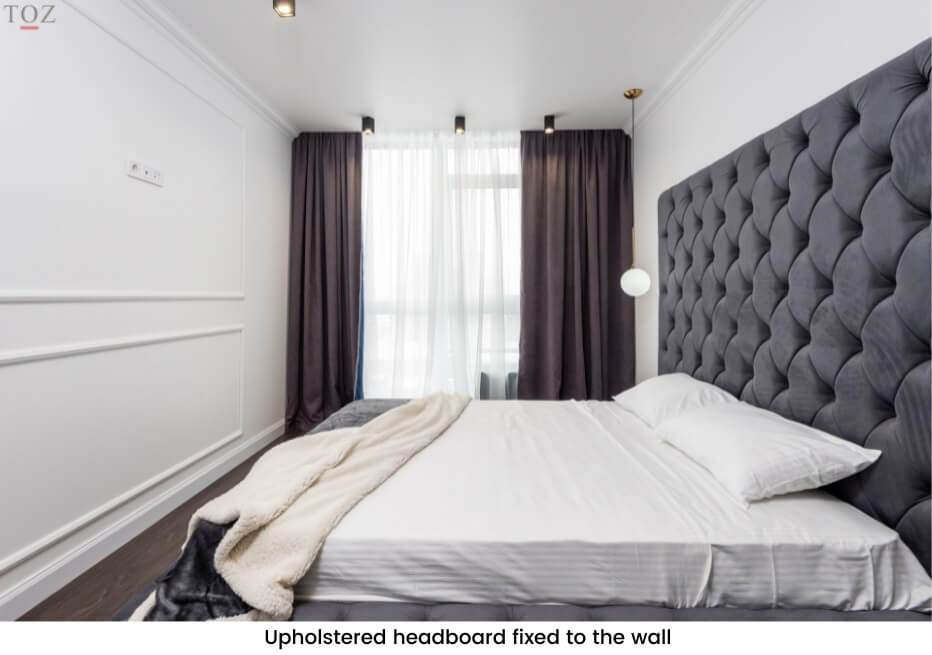
These headboards are a favourite of most designers; they look premium and have been in trend for the last few years. They are generally upholstered, so you can use it like a backrest while sitting on the bed. As these headboards are independent of the bed, you have plenty of opportunity to experiment with it to influence the aesthetics of the bedroom. For instance, you could make it taller, extend it beyond the bed on 2 sides to integrate it with bed-side tables or extend it to the two ends of the room. The only downside is that you will not be able to change the position of the bed as the headboard position is fixed.
5.2 Headboard fixed to the bed
This is the typical headboard that you find in most beds. They offer you the flexibility to change the position of the bed and come in a variety of designs, some of which are also upholstered. Experimentation for room aesthetics is relatively limited in this case.
In case you are getting an upholstered headboard:
- Check for the rub-count of the fabric material. Rub-count of a fabric is a measure of its durability from the abrasion it faces when you sit with your back against it. A rub-count of 25,000 – 30,000 is good; don’t take one with a rub-count below 15,000.
- Keep in mind that they will need regular deep-cleaning, similar to how it is done for sofas and carpets.
5.3 Headboard with storage
The advantage of having headboard storage is that you can do away with bed-side table, giving you more space on the sides of the bed. However, it makes the bed longer by a few inches, thus reducing the space available near the foot of the bed. So consider the space distribution around your bed while deciding on headboard storage.
6. Box-bed options (Under-bed storage)
Beds with under-bed storage are often referred to as box-beds or box khat in some regions. If you have conducted space planning for your bedroom, you would know if you need under-bed storage right away. However, it is difficult to decide on under-bed storage if you don’t have an immediate need for it. One school of thought says it’s better to plan for future needs by spending a little extra now, while another asserts that excess space encourages hoarding. So discuss this through with your family before taking a decision.
Personal experience:
My wife and I were faced with the above dilemma since we didn’t have any major storage need as such. After some research, we learnt that under-bed storage drawers are even sold separately. And since they run independently on wheels, they can be neatly placed under the bed. So we opted for under-bed storage for only one of our beds.
There are 2 types of box-beds:
6.1 Hydraulic bed
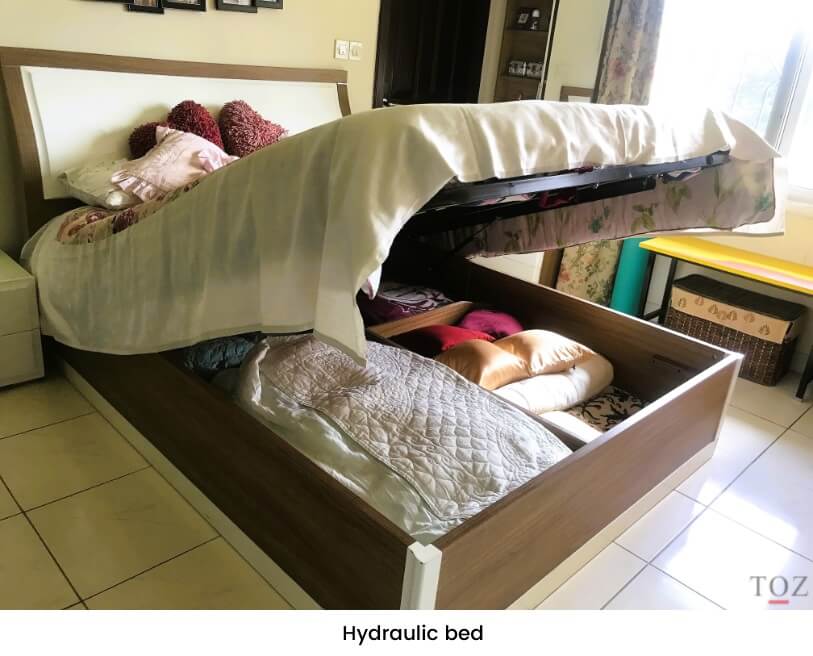
In this type, a hydraulic mechanism enables you to lift the upper lid of the bed along with mattress, much like you open the trunk of a hatchback car. Not only is the storage space huge, but you can also access all of it in one go. However, these beds are bulky and not easy to shift around. As regards the hydraulic system faltering, don’t worry, they very reliable today than they used to be a decade back. One concern with these beds is that old people or those with back issues could get injured due to the sudden jerk needed to lift the lid. Though some models boast of using premium fittings that need little effort, a minor risk of injury does remain. There are motorised ones as well, but they priced higher.
6.2 Drawers under the bed
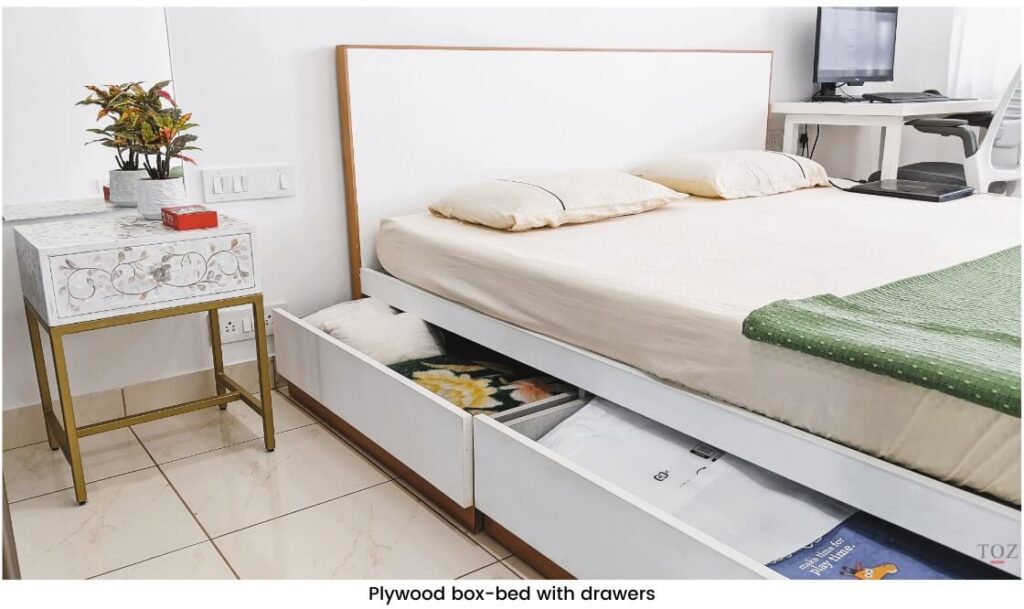
In this design, there are drawers of different sizes that slide under the bed, from the sides and/or the footboard. You can only pull the drawer you need and since there is lesser strain in pulling them, drawers pose a lower risk of injury. However, you need to ensure there is enough space available around the bed for you to be able to open the drawers fully. The overall space you get in these types of beds is lesser than the hydraulic ones and you don’t get access to the entire storage space in one go.
7. Make vs Buy (custom-made vs ready-made)
As a thumb rule, for the exact same furniture, it will always be cheaper to buy a readymade one than to get it custom-made. That’s because manufacturers of store furniture have scale and are able to build it at a much lower cost. Whether you get the bed custom-made or buy one from a store depends entirely on how much you want to customise it beyond standard designs.
If you can find a ready-made one in a store that meets your needs and checks all the boxes, go for it.
8. Conclusion
It is a difficult exercise to take all these 6 aspects in tandem and strike a balance, especially since there are no right or wrong answers. In fact, it might be a good idea to spread this exercise over a few days, so that you can relook at it with a fresh mind each day. But the effort is worth it, and you can be rest assured that you would select a bed that’s optimally suited to your needs.
Have questions or queries?
There are some pertinent queries that other readers have asked in the comments section at the end of this page; do go through them to see if any of them resonate with you. If you have a different question, feel free to mention it there; I will do my best to answer it. Please allow a few days for me to respond. If I (or any other reader) can answer it, then good. If not, atleast it will be something for the next reader to keep in mind. In case you have any learnings or experience to share, do mention it there for the benefit of other readers.
It is important to co-ordinate your bed with the rest of the furniture in your bedroom, not just in terms of looks but also in terms of storage and functionality. For instance, the size of your bed may influence the space available in front of the wardrobe, which in turn would affect whether you opt for swing or sliding shutters. If you have a box-bed, you may not need a lot of storage space in the wardrobe. So it’s important to consider all of them in tandem. To help you with that, you could check out my other posts on:
- 4 factors to consider when designing or selecting a wardrobe – this delves into factors like build material options, pros and cons of different types of shutters, designing wardrobe internals (shelves, drawers, fittings), buying readymade versus getting it custom-made.
- How to select the right ceiling fan for every room – this would be particularly useful in case you need a quiet fan (say, if you work from home and attend meetings) that also consumes less power.
In case you are planning on doing up other parts of your house as well, you could refer to some of my other posts:
- A practical guide to planning your kitchen design – This explores design and material considerations for cabinets, drawers, shutters, countertop, splashback, fittings, sink and lighting. It also details out a structured approach to designing your kitchen.
Share this post:

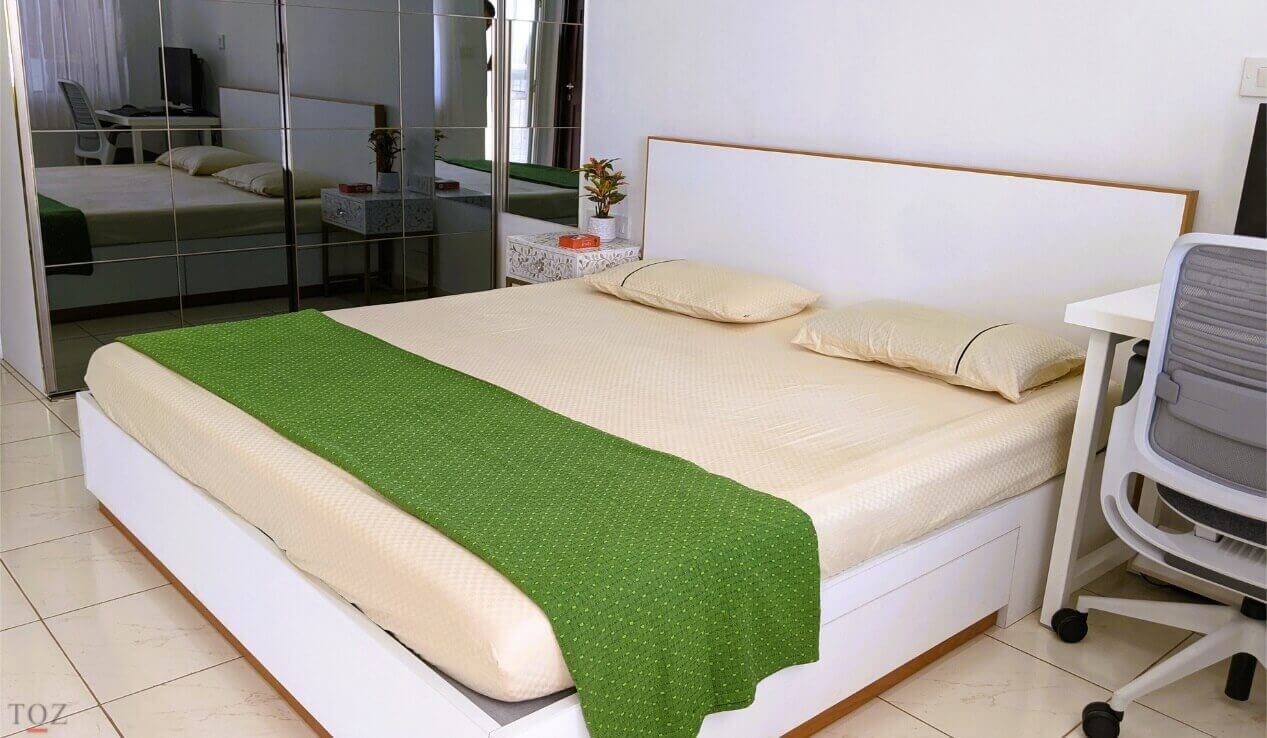
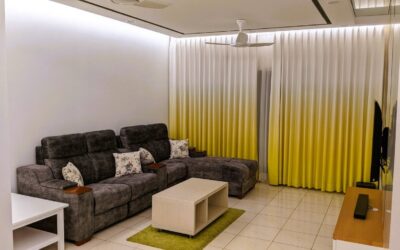
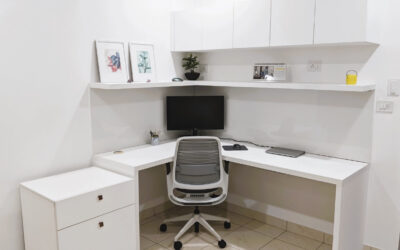
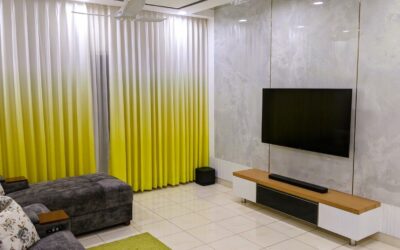

For kids room we’ve been debating between having a bunk bed with a table beneath to save space versus a storage bed on ground with a desk in a separate corner. What’s considerations should we factor in here?
So your 2 options are:
Option 1 – Bunk bed with a table below it
Option 2 – Normal bed with desk in a corner
Here’s are some things you could consider:
1) How important is floor space for the room? – With option 1, the additional floor space can be helpful for keeping other things like a musical instrument or something related to a hobby he has or may have in future.
2) Storage space – With option 2, you can use the space under the bed for storage as well. Not sure if you can do that with option 1; depends on the design of the bunk bed.
3) Flexibility of use – A bunk bed cannot be used by old people and it’s not ideal for guests either. A normal bed can be used by anyone.
4) Long-term perspective – A bunk bed might be great for today, but as your child grows, a normal bed may make more sense.
5) Feel of the room – Anything in the height range of 2.5 – 4.5 feet influences the feel of a room. Option 1 gives you more floor space, but a bunk bed may still make the room feel smaller.
6) Direction of light – Be it natural light or artificial, the source shouldn’t come from behind, else it will cause glare, eye-strain and shadows.